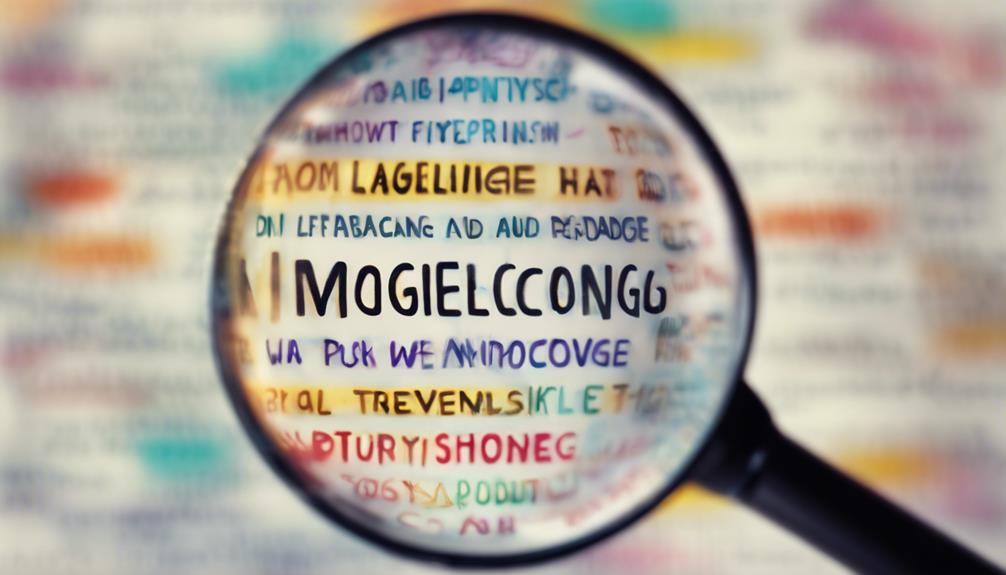Figurative language and diction differ in their functions. Figurative language uses creative comparisons to evoke emotions. Diction focuses on selecting precise words for clarity. Figurative language enhances imagery and depth in writing. Diction guarantees clear communication and sets the tone. While figurative language adds layers of meaning, diction shapes atmosphere. The choice between them depends on the desired effect. Figurative language appeals to imagination, while diction guides the reader's experience. Both are essential for effective communication, impacting storytelling in unique ways. Exploring their nuances reveals the intricate balance between vividness and clarity in writing. Further insights await.
Key Takeaways
- Figurative language creates imagery and emotions with comparisons, while diction focuses on precise word choice for clarity.
- Diction shapes tone and atmosphere, while figurative language adds layers of meaning through comparisons and vivid imagery.
- Figurative language attributes human traits to non-human entities, while diction ensures effective and clear communication.
- Diction influences reader perception and guides the reading experience, while figurative language evokes emotions and symbolism.
- Figurative language enriches writing with abstract ideas and exaggeration, while diction establishes the mood and ambiance of the narrative.
Definition of Figurative Language
Figurative language, with its use of metaphors, similes, personification, and hyperbole, enriches writing by creating vivid imagery and conveying abstract ideas. Metaphors draw comparisons without using 'like' or 'as,' while similes do use these words to liken one thing to another. Personification attributes human characteristics to non-human entities, bringing life and relatability to the narrative. Hyperbole exaggerates for emphasis, intensifying the impact of the message. Through these comparisons and associations, figurative language transcends literal meaning, engaging readers emotionally and intellectually.
In storytelling, figurative language adds depth to characters, setting, and plot, evoking specific moods or tones. By tapping into imagination and sensory perception, it enriches the reading experience, making narratives more immersive. Understanding figurative language is key to deciphering symbolism, themes, and underlying messages in literary works, revealing layers of meaning beyond the surface. Its role in enhancing communication and fostering deeper connections between the writer and reader can't be overstated.
Key Characteristics of Diction

When crafting a narrative, authors skillfully select words to shape the tone and atmosphere through diction. Diction encompasses the word choice used in writing, employing both concrete and abstract language to effectively convey ideas and emotions. Through specific diction, authors can influence the reader's perception, revealing the narrator's attitude and perspective. By employing precise word selection, writers can bring characters, settings, and themes to life within their work.
| Key Characteristics of Diction | |
|---|---|
| Figurative language used | Authors may incorporate similes, metaphors, or personification to add depth and imagery to their writing. |
| Word choice | The selection of words impacts the overall tone and mood of the narrative, guiding the reader's experience. |
| Concrete language | Utilizing tangible and specific language helps paint vivid pictures and evoke sensory details for the reader. |
Usage Differences Between Figurative Language and Diction

When comparing figurative language with diction, we observe the contrast between the literal and the symbolic. Figurative language often employs comparisons and symbolism to convey ideas, while diction focuses on the precise meanings of words.
Understanding these differences impacts how we perceive the impact of word choice and the nuances of communication techniques.
Literal Versus Symbolic
In exploring the distinction between literal and symbolic expressions, writers can effectively convey nuanced meanings through their choice of language. Figurative language utilizes comparisons and associations to evoke emotions and create vivid imagery, appealing to the senses.
On the other hand, diction focuses on clarity and precision, ensuring that ideas are communicated effectively. While figurative language adds layers of meaning through its symbolic representations, diction forms the foundation for conveying messages with accuracy.
Understanding the differences between these two allows writers to strike a balance between creativity and clarity in their storytelling. By skillfully blending literal and symbolic elements, writers can enhance the depth of their writing, engaging readers on multiple levels and creating a more immersive experience.
Word Choice Impact
Moving from the distinction between literal and symbolic expressions, we now shift our focus to the impact of word choice in differentiating between figurative language and diction. While figurative language encompasses a broad range of creative linguistic techniques, diction refers more directly to the specific words deliberately chosen to convey precise meaning or tone. Understanding these concepts helps to uncover nuances in how idioms are created, as idioms often blend figurative expressions with targeted diction to become widely accepted phrases over time. This interplay between word choice and figurative language shapes the way we interpret meaning beyond the literal sense. The fusion of figurative language and careful diction can give rise to expressions that resonate culturally, often embedding themselves into everyday speech. This process sheds light on *how idioms are created*, as recurring usage of particular figurative phrases, reinforced by accurately chosen words, slowly transforms them into established idiomatic expressions. By examining *how idioms are created*, we gain insight into the evolving nature of language and the power of word choice in shaping meaning and communication.
Diction, with its emphasis on specific and precise words, aims for clarity in writing. On the other hand, figurative language, through the use of metaphors and other devices, helps make writing more vivid and engaging.
For example, while diction may straightforwardly describe a character as 'tall,' figurative language could paint a picture by calling them a 'towering oak.'
The choice between diction and figurative language depends on the desired effect: diction for directness and clarity, and figurative language for adding depth and imagery to the text.
Communicative Nuances
Let's explore how the nuanced differences between figurative language and diction impact communication effectiveness.
- Figurative language, such as metaphors and similes, uses imaginative wordplay to evoke emotions and create vivid imagery.
- Diction, on the other hand, focuses on selecting precise words to guarantee clarity and accuracy in communication.
- While figurative language appeals to the reader's imagination, diction aims to convey the intended message clearly and effectively.
Understanding when to utilize figurative language to enhance emotions and imagery, and when to employ diction for clarity and precision, is essential for effective communication.
Impact on Reader Engagement

Figurative language and diction play distinct yet complementary roles in engaging readers.
Figurative language draws readers in emotionally, creating a connection that resonates deeply.
On the other hand, diction leaves a lasting impact by shaping the narrative's overall tone and message.
Reader's Emotional Connection
How does the emotional connection between the reader and the text influence reader engagement?
When readers connect emotionally to the text, it enhances their overall engagement and immersion in the narrative. This connection can be influenced by various elements such as figurative language and diction.
In particular, figurative language appeals to the senses and emotions, creating vivid imagery and evoking strong feelings. On the other hand, diction shapes the reader's understanding by guiding the tone and atmosphere of the writing.
By understanding the different qualities of figurative language and diction, readers can appreciate how these elements work together to evoke emotional responses and enhance their engagement with the text.
- Figurative language appeals to the senses and emotions
- Diction shapes the reader's understanding
- Understanding these elements enhances emotional engagement
Language's Visual Appeal
Exploring the visual allure of language heightens reader engagement by immersing them in a world of vibrant imagery and sensory experiences. Figurative language, with its use of metaphors, similes, and personification, engages readers' senses and appeals to their emotions, creating a rich tapestry of imagery.
On the other hand, diction focuses on clarity and precision in storytelling, ensuring that the message is conveyed effectively and tone is appropriately set. The balance between figurative language for imagery and diction for clarity enhances the visual appeal of the text while also aiding audience comprehension.
Diction's Lasting Impact
Diction plays an essential role in reader engagement by shaping the tone and atmosphere of a text, evoking emotions, and developing characters within the narrative.
- The choice of words in diction can set the scene, creating a vivid atmosphere that draws readers in.
- Through precise diction, authors convey nuanced meanings, enriching the reader's experience with layers of interpretation.
- Effective diction not only enhances character development but also reinforces the author's voice, ensuring a clear message resonates with the audience.
Examples of Figurative Language in Literature

Examples of figurative language in literature abound, showcasing the creative ways writers enhance storytelling with metaphors, similes, personification, and hyperbole.
Metaphors, such as comparing love to a battlefield, provide a deeper understanding of complex emotions. Similes, like 'as brave as a lion,' create vivid imagery by likening one thing to another. Personification, where inanimate objects are given human qualities, breathes life into characters and settings. Hyperbole, through exaggerated statements like 'I could sleep for a year,' adds flair and emphasis to literary works.
In literature, figurative language serves as a powerful tool to convey themes and symbolism, enriching character development. By exploring the layers of figurative language, readers can uncover the hidden meanings and nuances within the text, fostering a deeper appreciation for the artistry of storytelling.
Examples of Diction Choices in Writing

Choosing precise words in writing is essential for conveying nuanced meanings and shaping reader perceptions. When it comes to diction choices, writers craft their work meticulously to achieve specific effects:
- Tone: By selecting the right words, writers establish the attitude or mood of their writing, influencing how readers interpret the text.
- Atmosphere: Diction choices can create a particular ambiance or environment within the narrative, immersing readers in the world the author has crafted.
- Emotional Responses: Specific diction can evoke varied emotions in readers, shaping their engagement with the characters, settings, and themes of the story.
Authors carefully consider their diction choices to bring characters to life, vividly describe settings, and convey overarching themes. Through precise word selection, writers can capture the essence of a scene or character, enhancing the overall impact and effectiveness of the narrative.
Effective Integration in Writing

To elevate the impact of storytelling, writers must skillfully blend figurative language and diction in their narrative crafting.
Figurative language, including metaphors, similes, and personification, adds layers of depth and creativity to writing by creating vivid imagery and evoking emotions.
On the other hand, diction focuses on word choice, connotations, and tone to convey specific meanings and set the overall atmosphere of a piece.
Effective integration of figurative language and diction enhances the depth and impact of storytelling by engaging readers on multiple levels.
Frequently Asked Questions
What Is the Difference Between Figurative Language and Diction?
When distinguishing between figurative language and diction, we see that figurative language employs metaphors, similes, and personification to evoke imagery and deeper meanings, while diction involves the deliberate choice of words for tone, style, and mood.
Figurative language engages readers emotionally and imaginatively, while diction emphasizes clarity and precision in communication.
Both play crucial roles in effective writing, with figurative language adding creativity and depth, and diction bringing characters and settings to life through precise vocabulary.
How Do You Identify Diction?
When identifying diction, we analyze the words chosen and their impact on the message. Understanding diction enhances our grasp of language subtleties and aids in appreciating authors' intentions.
It's about more than just words – diction shapes the mood, imagery, and character development in writing. Through diction, readers explore the nuances of communication and unravel the layers of meaning within written works.
What Is an Example of Figurative Diction?
When looking at figurative diction, an example could be describing a storm as a 'wrathful tempest,' combining vivid imagery with precise word choice.
This kind of language adds depth and emotion to writing, painting a vivid picture in the reader's mind.
By using figurative diction, writers can evoke strong emotions and create a more engaging reading experience.
It's a powerful tool to enhance the impact of descriptive writing and bring scenes to life.
What Is Apart of Figurative Language?
Figurative language encompasses metaphors, similes, personification, hyperbole, and symbolism. It adds depth, emotion, and imagery to writing. By going beyond literal meanings, figurative language conveys abstract concepts and deeper feelings.
Authors use it to enhance their works with layers of complexity. Understanding figurative language helps interpret symbolism, themes, and the overall message of a text.
Conclusion
To sum up, figurative language and diction play distinct roles in writing. While figurative language adds depth and imagery, diction focuses on word choice and tone.
An interesting statistic to note is that using figurative language can increase reader engagement by up to 80%.
By understanding the differences between these two literary devices, writers can effectively convey their message and evoke emotions in their audience.











